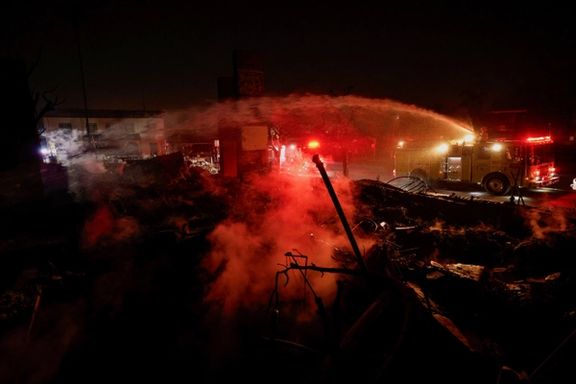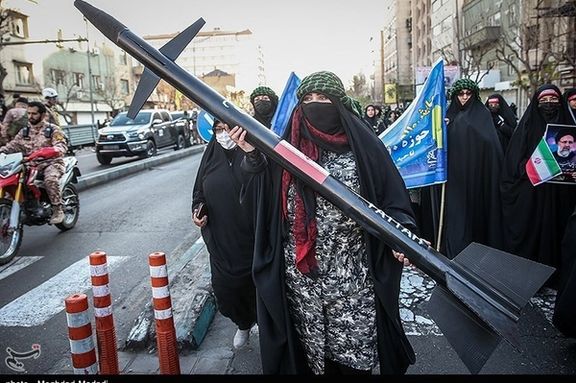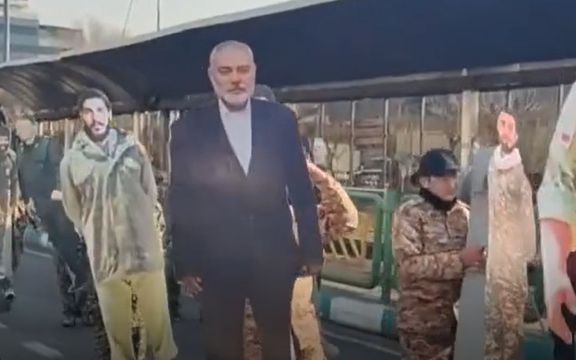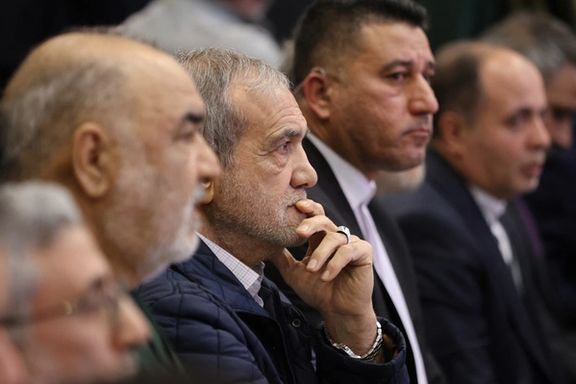Turkey urges Iran to back Ankara's fight against PKK

Turkey’s Foreign Minister Hakan Fidan says Ankara seeks to strengthen ties with its eastern neighbor and expects Tehran to support its fight against the Kurdistan Workers’ Party (PKK).

Turkey’s Foreign Minister Hakan Fidan says Ankara seeks to strengthen ties with its eastern neighbor and expects Tehran to support its fight against the Kurdistan Workers’ Party (PKK).
“There are some who think differently about PKK in Iran. But it is not a secret that we call on all the countries – the US, Russia, etc. – not only Iran, not to support PKK or at least not to remain indifferent,” Fidan said Friday during a press conference in Istanbul.
He made the remarks in response to a question about IRGC Quds Force Chief Esmail Qaani's alleged meeting with the PKK-linked YPG leaders.
Fidan also suggested that Iran might reconsider its regional policies and adopt a new strategy in the Middle East following developments in the region, including the fall of Tehran’s ally Bashar al-Assad in Syria.
Ankara is known as the main supporter of the Syrian rebels led by Ahmed al-Sharaa, also known by his nom de guerre Abu Mohammad al-Julani, who toppled Assad's government in Damascus.
Fidan said the new Syrian administration should be given a chance to address the presence of Kurdish militants in the Arab country, reiterating that the Turkish military would act if it did not.
Since the fall of Assad on December 8, 2024, Ankara has repeatedly said the Kurdish YPG militia must disband, lay down its weapons, and have its foreign fighters leave Syria.
Turkey has listed the YPG, which spearheads the US-backed Syrian Democratic Forces (SDF), as a terrorist organization linked to militants waging a decades-old insurgency against the Turkish state.
However, Washington considers them a key ally battling Daesh (ISIS) terrorists.

Iran's hardline media described the Los Angeles fire as an act of divine anger and a punishment for the United States' support of Israel in the Gaza conflict.
The Kayhan newspaper, funded by Supreme Leader Ali Khamenei, wrote on its front-page headline Saturday that by supporting Israel in Gaza, the US had "created apocalyptic scenes," and now "the cries of the oppressed children of Gaza and the Palestinian mothers have caught up with America, imposing a similar situation on the state of California and the city of Los Angeles."
The Jam-e Jam newspaper also ran a similar story on its front page with the headline "Fire-Angeles."
The newspaper referred to Donald Trump's comment that the Middle East would turn into hell if Israeli hostages were not freed before his inauguration and described the Los Angeles fire as "America's hell."
A representative of Iran's Supreme Leader Ali Khamenei also called the California fires "God's revenge against the leaders of America" over what he called their complicity in Israel's war in Gaza.
"A city the size of Gaza has burned, while all its inhabitants were American capitalists. This fire was God’s revenge against the American leaders," said Rasoul Falahati, a representative of Khamenei in Gilan province in northern Iran.
On Tuesday, US President-elect Donald Trump warned during a press conference at his Mar-a-Lago estate in Florida that "all hell will break out in the Middle East" if Hamas does not release the hostages by Inauguration Day, repeating the statement several times.
The Arabic-language Al-Alam Network, owned by the state media corporation Islamic Republic of Iran Broadcasting (IRIB), shared images showing the destruction caused by the Los Angeles fires and compared them to the devastation in Gaza.
Other Iranian media also used terms like "Los Angeles in hell" and "the infernal city," criticizing what they described as "very weak" crisis management in the US.
The Fars News Agency reported that "the infernal fire of Los Angeles is days away from being contained."
On Friday, former Iranian Foreign Minister Mohammad Javad Zarif tweeted about the destruction caused by the California wildfires, comparing it to Gaza.
"Grim footage out of California is reminiscent of ravaged homes, schools, and hospitals in Gaza," Zarif wrote. "It's only human to sympathize with Californians who've lost everything to the wrath of nature—particularly as many there have stood with Gazans who lost everything to the savagery of Israel."
Meanwhile, government offices and schools across Iran were shut down on Saturday due to a natural gas shortage, extending the ongoing energy crisis that began at the start of winter with widespread gas and electricity shortages.
Since Tuesday, six simultaneous blazes have swept through Los Angeles County neighborhoods, claiming at least 11 lives and damaging or destroying 10,000 structures. The toll is expected to rise as firefighters conduct house-to-house searches.
The largest wildfire ravaging parts of Los Angeles this week changed direction on Saturday, prompting additional evacuation orders and presenting a fresh challenge to exhausted firefighters.

A member of the US House of Representatives has called for enhancement of Washington's defense capabilities in response to Tehran's unveiling of a new loitering munition drone.
"Iran’s Rezvan loitering munition and its growing drone capabilities underscores the need for the US to bolster its own defense capabilities," said Congressman Pat Fallon in a post on his X account on Saturday.
"Innovative anti-drone defenses and countermeasures are essential to our military's readiness," he added.
His comments came two days after Iran’s Islamic Revolutionary Guard Corps (IRGC) unveiled its latest loitering munition drone, the Rezvan, during military drills codenamed Great Prophet 19.
The drone, with a range of 20 kilometers and an operating time of 20 minutes, is designed for rapid deployment and targeted attacks, particularly in complex terrain, according to the IRGC.
The suicide drone is fired from a cylindrical launcher and transmits live video to the operator, allowing for precise target selection and engagement, IRGC media Tasnim reported.
The Great Prophet 19 exercise was the latest in a series of drills conducted by Iran's military to showcase its capabilities and project a message of strength in the region, following consecutive defeats for its allies since September.

An IRGC General has acknowledged that a highly publicized large-scale drill conducted by the paramilitary Basij forces on Friday in Tehran failed to attract significant participation, despite the provision of free food and gifts.
Hassan Hassanzadeh, the commander of Tehran’s Mohammad Rasoulollah IRGC base, told local media that the trend of declining participation has intensified since the fall of Iran’s ally, Bashar al-Assad, in Syria. In a rare admission, he acknowledged that many IRGC and Basij members did not respond to calls to join what was intended to be a 110,000-strong drill.
However, the actual participation figure remains uncertain, as Hassanzadeh also said that “According to preliminary figures I have received, at least 27,000 Afghan brothers and sisters residing in Iran have filled out the participation form for the drills.”
Hassanzadeh, referring to what he described as a trend of non-cooperation by IRGC and Basij members with IRGC programs, stated: "Unfortunately, many of our colleagues who have had the honor of serving in the Basij and the IRGC have either declined to participate for various reasons or have not yet given a definitive response. This is a trend that we have seen increase since the events in Syria."
The event appeared more like a parade through the streets of the capital than a military drill intended to prepare for the defense of Tehran. Many Iranians on social media suggested that the exercise was aimed more at intimidating residents and deterring anti-government protests than preparing for a potential foreign attack.

The participants included anti-riot forces riding in groups of motorcyclists, a formation commonly used during protests. Typically, two men share each motorbike, with the passenger armed with clubs or chains to strike protesters.
The event also featured men carrying cardboard cutouts of “martyrs,” such as former Hezbollah leader Hassan Nasrallah, killed by Israel, and Ismail Haniyeh of Hamas, assassinated in Tehran last year. Heavily armed IRGC forces were present, carrying assault rifles and riding in pick-up trucks mounted with heavy machine guns. Some participants, dressed as early Islamic warriors, brandished oversized swords—all these displays seemingly intended to intimidate the public.

An official IRGC announcement highlighted the distribution of free food to all participants, along with a few hundred “wedding gift packages” for supporters preparing to get married. In Iran, free food handed out at such events is commonly referred to as “sandis,” a term often used humorously. Those who attend government-organized gatherings solely for the freebies are mockingly called “Sandiskhor,” or freeloaders.
Iran International analyst, Morad Veisi pointed out before the event that “The timing of the drill coincides with political shifts in the US, including the return of Donald Trump to the White House, and a weakening of Tehran’s regional position, which have raised concerns within the Islamic Republic’s ruling circles.”

Severe natural gas shortages forced the closure of government offices and schools across nearly two-thirds of Iran’s provinces on Saturday, amid declining production and high winter consumption.
Officials say the closures, which necessitated online schooling, aim to manage dwindling resources.
Hassan Mousavi, spokesperson for the National Iranian Gas Company, said gas consumption on January 10 rose significantly compared to the same day last year.
“605 million cubic meters of natural gas were allocated to the residential, commercial, and small-scale industrial sectors on Friday, which represents a 10 percent increase compared to the same period last year,” he added.
Tehran Province completely shut down its government offices, with similar closures reported in provinces like Isfahan, Fars, and Qom in central and southern Iran, as well as in two northeastern provinces and several in the northwest and north.
This is not the first time such measures have been implemented. Recent weeks have seen similar shutdowns in Tehran and other provinces, often linked to air pollution or energy crises.
Mohammad Sadegh Mo'tamedian, Governor of Tehran, remarked last month that such moves merely “shift the crisis from one point to another.”
The crisis has revived memories of the summer, when nationwide blackouts due to insufficient power generation led to significant disruptions. With no immediate solutions in sight, Abbas Aliabadi, Minister of Energy, recently acknowledged the gravity of the situation.
“The gas shortage is a reality,” Aliabadi told parliamentarians on January 5, adding, “It cannot be resolved within two months.”
Aliabadi spoke about a shortage of 20,000 megawatts of electricity and a difficult summer ahead, adding: "Let’s hope this doesn't happen because while the cold of winter can be managed by wearing warm clothing, navigating the conditions of summer is not that simple."
Iran’s President Masoud Pezeshkian has repeatedly described the situation as dire. “In critical areas—electricity, water, gas, the environment, and finance—we are on the edge of a precipice,” he warned.
Although Iranian officials insist that energy consumption is rising, the country is in the midst of an economic crisis. The main issue is declining production in Iran's main gas fields in the Persian Gulf, where natural gas pressure is falling and tens of billions of dollars in new investment and technology are needed.
Iran's energy shortage is primarily driven by a combination of outdated infrastructure, inefficient energy consumption, and a lack of investment in modern technologies. The country's power grid, gas pipelines, and energy generation plants often operate at or near full capacity, making them vulnerable to failures and inefficiencies.
The ongoing US sanctions have limited access to foreign technology and investment, preventing the country from modernizing its energy systems.
Other contributing factors include the increasing demand for electricity during hot summers and cold winters, alongside insufficient efforts to develop alternative renewable energy sources. The over-reliance on fossil fuels for both electricity generation and heating exacerbates the issue, while Iran's ability to manage energy demand through strategic planning and conservation has remained limited.
Officials have launched conservation initiatives, including a campaign titled “Two Degrees Less Consumption.” Despite this, the challenges of balancing demand with supply persist, raising concerns about Iran’s ability to cope with the energy crisis both in winter and during the hotter summer months ahead.

Iranian President Masoud Pezeshkian will visit Moscow on January 17 to meet Russian President Vladimir Putin and sign a strategic cooperation agreement, the Iranian Embassy announced.
The statement followed a meeting on Friday between Kazem Jalali, Iran's Ambassador to Moscow, and Andrey Rudenko, Russia's Deputy Foreign Minister. Russia, confirming the meeting, said: "Current issues on the bilateral agenda were discussed, including upcoming high-level contacts," as quoted by Tass.
The initiative comes after both Iran and Russia lost their key Middle Eastern ally, Bashar al-Assad of Syria, last month, when Islamic insurgents swept down from the north and seized Damascus within days.
Discussing the specifics of the deal, Jalali told Iran's state-run Young Journalists Club (YJC), "The independence and security of our country, as well as self-reliance, are crucial elements, and we are not particularly inclined to align ourselves with any specific bloc."
"National independence is of great importance to the Islamic Republic of Iran. After all, we have been paying the price for it for 45 years," he added in an article published Saturday.
Last week, government spokesperson Fatemeh Mohajerani also told Sputnik that Iran expects to sign a comprehensive cooperation agreement with Russia on January 17, during President Masoud Pezeshkian's visit to Moscow.
Mohajerani told the media that the president's upcoming visit to Moscow is expected to advance two major initiatives: "The North-South Corridor, which is already underway, and the plan to transfer Russian gas to Iran—both of which have been key points of agreement between the two sides."
Tehran and Moscow first signed a long-term agreement in March 2001, officially titled the Treaty of the Foundation of Mutual Relations and the Principles of Cooperation between the Islamic Republic of Iran and the Russian Federation Act. Initially set for ten years, it was extended twice for five-year terms.
Despite similar announcements about a new agreement since 2020, a renewed treaty has yet to be finalized.
According to Iran’s ambassador to Russia, the two countries agreed in 2021 to extend the treaty for another five years, with its expiration now set for 2026.
In 2023, reports suggested potential challenges in developing a new agreement with Russia, although few details about its content have been made public.
Some commentators in Iran have criticized Russia for the fall of Iran's ally, Bashar al-Assad, noting that Moscow failed to provide sufficient support when insurgents advanced toward Damascus. Ataollah Mohajerani, a government-aligned analyst, wrote in Etemad daily on Saturday that Russia could similarly abandon the Islamic Republic if its interests demanded it.
The Islamic Republic also has a long-term agreement with China, though its details remain undisclosed. Throughout its 45-year standoff with the United States and the accompanying international isolation, Tehran has consistently sought to deepen its cooperation with Moscow and Beijing.